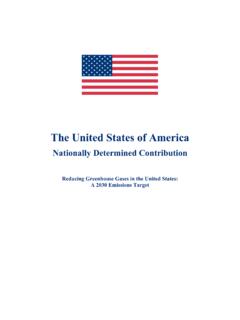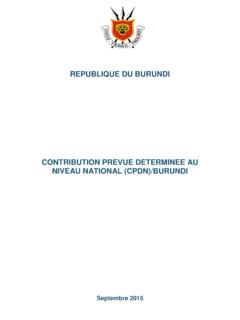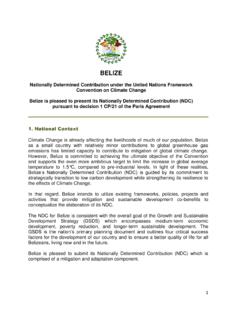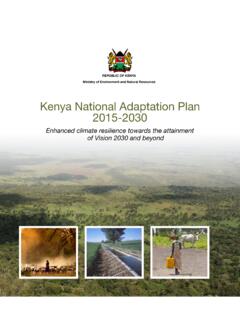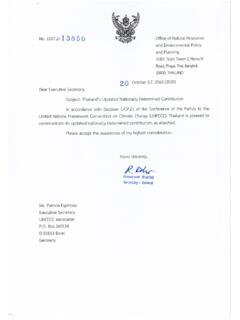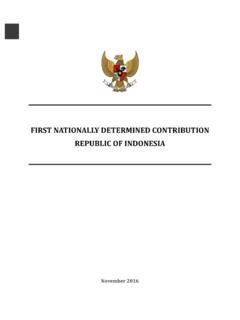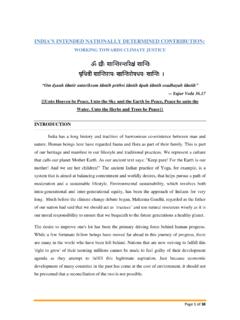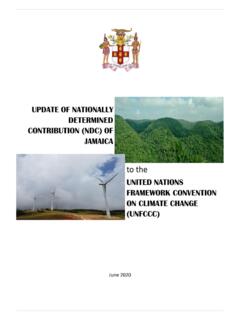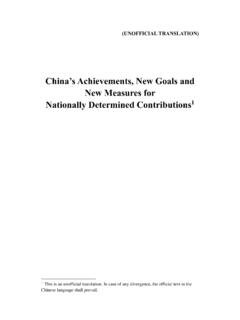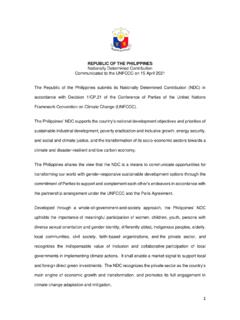Transcription of Intended Nationally Determined Contribution of Viet Nam
1 1 Intended Nationally Determined Contribution of Viet Nam I. Introduction Viet Nam is willing to respond to climate change, which is demonstrated by the range of national policies and concrete greenhouse gas (GHG) mitigation and climate change adaptation measures that have been undertaken throughout the past decade, funded primarily by domestic financial resources. Additionally, Viet Nam supports achieving a legal agreement with the participation of all Parties to the United Nations Framework Convention on Climate Change (UNFCCC) in order to keep the global average atmospheric temperature increase, since pre-industrial times, at below 2oC.
2 Viet Nam signed the UNFCCC in 1992 and ratified it in 1994; signed the Kyoto Protocol (KP) in 1998 and ratified it in 2002; set up a National Steering Committee to implement the UNFCCC and KP; submitted to the UNFCCC Secretariat its Initial National Communication (2003), the Second National Communication (2010), and the Initial Biennial Update Report (2014), reflecting the latest climate change response efforts and GHG inventories. In 2008, the Government issued the National Target Programme to Respond to Climate Change (NTP-RCC) in order to assess climate change impacts and develop adaptation and mitigation measures.
3 Climate change was mainstreamed into the National Socio-Economic Development Strategy (2011-2020) and Socio-Economic Development Plan (2011-2015), and policies on disaster risk reduction, coastal zone management, and energy supply and use. Economic sectors and provinces have developed Action Plans to respond to climate change. In 2011, the National Climate Change Strategy was issued, outlining the objectives for 2011-2015 and 2016-2050, and priority projects to be implemented in the period of 2011-2015.
4 The strategy identifies climate change responses that are vital for the development of the country. Responding to climate change must be associated with sustainable development and a transition towards a low-carbon economy, take advantage of opportunities to increase competitiveness and strengthen the national position, and carry out adaptation and mitigation efforts in parallel. In 2012, the National Green Growth Strategy was approved, which includes mitigation targets and measures; and regulations on linking with international carbon markets.
5 In 2013, the Law on Natural Disaster Prevention and Control was enacted, aiming to address diverse natural hazards that affect the country, which are primarily climate change related. The 2014 Law on Environment includes a full chapter on climate change. The development and implementation the above-mentioned policies and activities to respond to climate change relies mainly on domestic human and financial resources. Viet Nam s INDC includes a mitigation and an adaptation component.
6 The mitigation 2 component includes both unconditional and conditional contributions. The unconditional contributions are measures that will be implemented using domestic resources, while the conditional contributions are measures that could be implemented if new and additional international financial support, technology transfer and capacity building are received. Viet Nam s INDC identifies the GHG reduction pathway in the 2021-2030 period. With domestic resources GHG emissions will be reduced by 8% by 2030 compared to the Business as Usual scenario (BAU).
7 The above-mentioned Contribution could be increased up to 25% with international support. The adaptation component describes the climate change adaptation actions that are currently being implemented. It also identifies adaptation gaps in terms of institutional and policy arrangements, financing, human resource capacity and technology and prioritized adaptation measures for the 2021-2030 period. It is estimated that the national budget will be able to meet approximately one third of the financial needs to implement adaptation measures in this period, and will seek international support and private sector investment for the remainder.
8 Viet Nam s INDC has been developed with the participation and contributions from different line ministries, non-governmental organisations, research institutions, business sector representatives as well as international development partners. Through this INDC, Viet Nam reaffirms its willingness to respond to climate change and contribute to the objective of the UNFCCC. Viet Nam believes its Contribution is fair and ambitious, feasible and achievable. It is committed to continuing to address climate change based on domestic resources and international support.
9 II. GHG Mitigation Component GHG mitigation activities prior to 2020 Viet Nam is one of the first countries to ratify the UNFCCC and the KP and has actively been researching and implementing GHG mitigation measures. As of June 2015, Viet Nam had 254 Clean Development Mechanism (CDM) projects accredited and registered by the CDM Executive Board (EB). Viet Nam is ranked number four internationally for number of projects, with a total GHG reduction amount of approximately million tCO2e in the credit period.
10 Among the 254 projects, energy projects account for , waste treatment for , reforestation and afforestation for and other projects for To date, more than 12 million Certified Emission Reductions (CERs) credits have been issued by the EB for Viet Nam, which is ranked eleventh in the world. The Government has issued many policies on energy saving and efficiency, such as the National Target Programme on Energy Efficiency (2006), the Law on Economical and Efficient use of Energy (2010).
